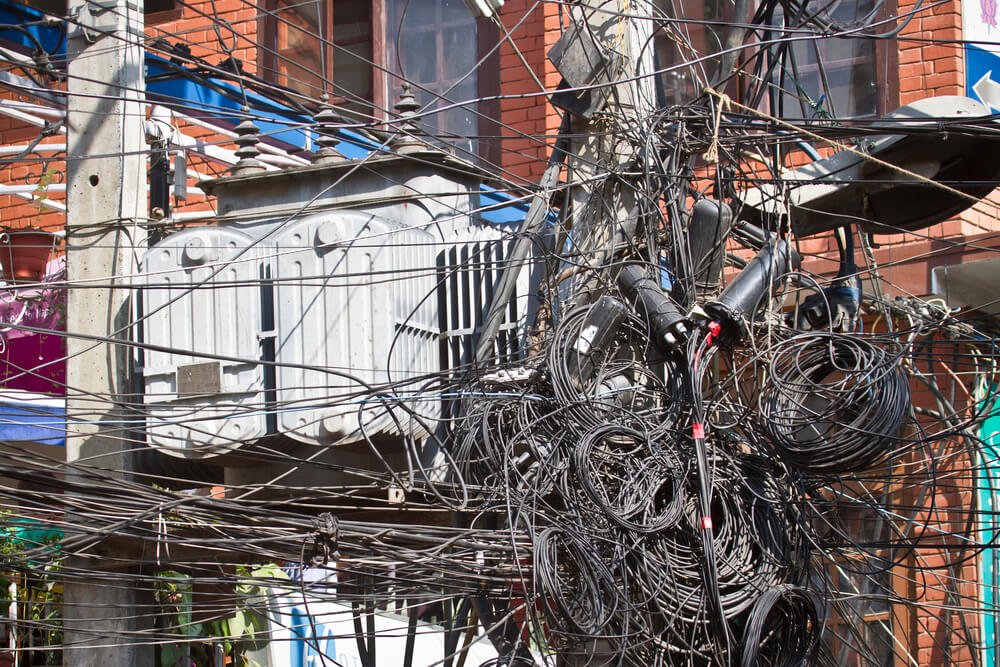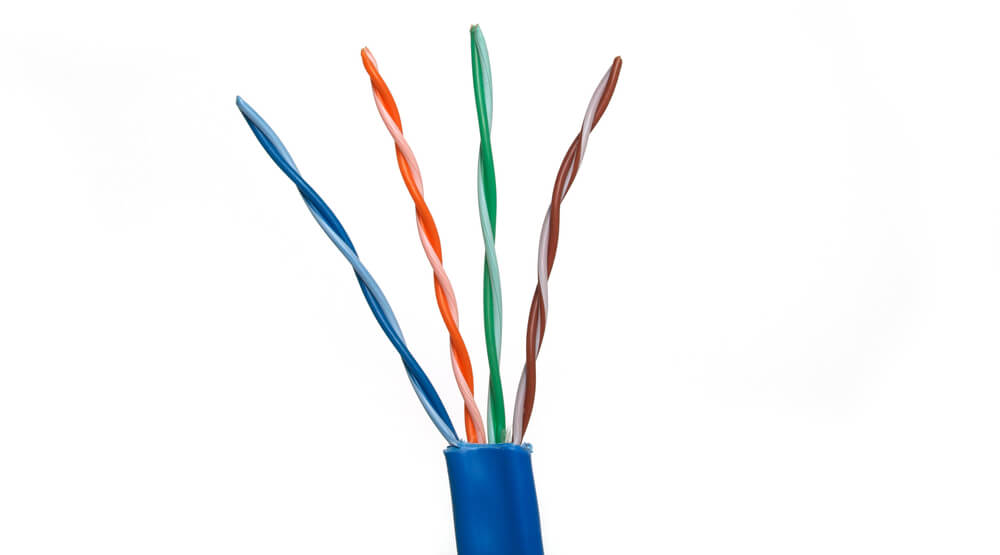Structured cabling supports various data, video, and voice systems. It is a planned and designed cabling system rather than one thrown together.
Typically, a structured cable approach is used in commercial and industrial buildings, providing flexibility, scalability, and other benefits.
People often associate structured cabling with data centers, which have many cables running through steel overhead racks.
However, structured cabling also applies to small and mid-sized businesses.
Organizations can use a structured cabling setup to support a variety of different systems, including:
- Telephone systems
- Computer networks
- Video systems
- Audio systems
- Security systems
- Building management systems
The Problems With Unstructured Cabling
Imagine if every appliance and light in your home had a separate 100-foot or longer extension cord to the main electrical panel.
That would create a large mess of cords and tripping hazards.

Further, picture those extension cords without labels. When you unplug a cord from the main panel, you cannot tell what appliance or light will lose power.
Fortunately, home electrical wiring is structured — with subpanels and connected outlets that appliances and lights can be plugged into. Most electricians label each breaker on the main and sub panels for easy identification.
Similarly, structured cabling in a commercial building allows for easy cable management and identification.
If you add more users and devices to a section of your building with the data equivalent of an electrical subpanel, less time and effort are required. You will also have a setup that will not have bandwidth bottlenecks.
Another example of unstructured cabling can be seen above the streets in some parts of the world. This visual makes it easy to understand why adds and changes can be expensive when there is a lack of structure.

Benefits
Structured cabling is crucial to organizations that rely heavily on fast, dependable internet connectivity for different devices and systems.
Here are some of the main benefits of investing in structured cabling:
Reliability: It’s more reliable than traditional wiring methods. This is because it uses high-quality materials and is designed to last.
Scalability: It’s scalable—it can be easily expanded as your business grows.
Cost-effectiveness: It’s a cost-effective solution for businesses. It is less expensive to maintain than traditional wiring methods.
Flexibility: It’s flexible. It can be easily adapted to changes in a business’s needs.
Network performance: A network can improve the performance of a business’s devices and systems by providing the right level of bandwidth.
Structured cabling is an excellent solution for connecting your business’s devices and systems. It is reliable, efficient, and cost-effective.
Components
The main components of structured cabling include the following.
Cable: The cable is the physical medium that carries the signal from one point to another.
Connectors: Connectors join two or more cables or connect a cable to a piece of equipment.
Jacks: Jacks connect a cable to a wall outlet or patch panel.
Patch Panels: Patch panels connect multiple cables or a cable to a piece of equipment.
Racks: In large, open spaces, cables run through racks.
Types of Cable Used
There are several different types of cable used in structured cabling. The most common types of cable are:
Twisted Pair Cable: A twisted pair cable has multiple sets of two insulated wires twisted together. The current standards for business computer networks are Category 6 (CAT6) and Category 6a. CAT6 transmits data at speeds up to 10Gbps, while CAT6a is better for long distances.

Fiber Optic Cable: Fiber optic cable is made of thin strands of glass or plastic. It is used within a structured cabling setup when speeds greater than 10Gbps are required to reduce bottlenecks. However, fiber optic cable is more expensive than twisted pair cable.
Coaxial Cable: Coaxial cable has a copper core surrounded by an insulating material. These days, businesses rarely rely on coaxial cable for voice and data, but it is sometimes used for video, such as CCTV.
SubSystems
Structured cabling companies comprise this assemblage of six subsystems, each with its specific function, subsystems, and components. The six structured cabling subsystems are:
Horizontal Cabling: The cable that connects end-user equipment to the telecommunications closet (TC) or wiring closet is typically CAT6 unshielded twisted pair (UTP) or shielded twisted pair (STP).
Vertical Cabling: With a vertical setup, the cabling runs from the workstation to the floor above or below and then to the telecommunications room. Vertical cabling is also known as backbone cabling.
Entrance Facility Structured Cabling: An entrance facility is a room or area where the telecommunications cabling system enters a building from the outside. It protects the cabling system from the elements.
Consolidation Point Structured Cabling: A consolidation point is where multiple cabling runs are terminated and connected. This allows for more organized and efficient cabling infrastructure.
Telecommunications Enclosure: A telecommunications enclosure houses telecommunications equipment. It is typically made from metal or plastic and is often used to protect it from the elements.
Work Area Components: The work area encompasses all components between a wall jack and an Ethernet-based device, such as a desktop computer. This includes the patch cords between wall jacks and the Ethernet devices. A wiring closet on the same floor often serves a work area.
The Structured Cabling Installation Process
Structured cabling involves installing a network of cables and associated hardware, such as patch panels and jacks. This combination provides a business’s communication infrastructure.
The first step in structured cabling installations is determining the network’s requirements, including the number of connected devices and the type of applications used.
Once the requirements are known, the next step is to select the appropriate cable type and design the network layout. The type of cable used will be determined by the applications and the number of devices that will be connected.
The size and shape of the area to be covered will determine the network layout. After the cable type and network layout have been determined, the next step is to install the cables.
The cables should be installed in a manner that will minimize interference and maximize performance.
Once the cables have been installed, the associated hardware is added. This includes routers, switches, and other devices that will connect to the network.
After installing the hardware, the next step is to test the network to ensure it functions properly. This includes testing the bandwidth, latency, and other performance factors.
The installation process is documented once the network is up and running and functioning correctly.
Maintenance
A structured cabling system is the backbone of a business’s communication infrastructure and needs to be appropriately maintained to keep the business running smoothly.
A well-maintained cabling system improves a network’s performance and reliability. In today’s fast-paced world, businesses can’t afford downtime for communications infrastructure.
Keeping your cabling system in top condition can avoid costly downtime and keep your business running smoothly.
Frequently Asked Questions
A structured cabling installation provides comprehensive voice, video, and data infrastructure. It gives telephone service or transmits data through a computer.
Low-voltage cable refers to electrical wires and jacks used in applications that require less infrastructure, such as phones, cameras, fire alarms, intercoms, and internet service.
Structured cabling standards help organizations install wiring in a way that prevents messy tangles by keeping the whole wiring infrastructure organized. This results in more even bandwidth, less downtime, and less room for human error.
The six components of structured cabling are Horizontal Cabling, Vertical Cabling, Entrance Facility, Consolidation Point, Telecommunications Enclosure, and Work Area.


